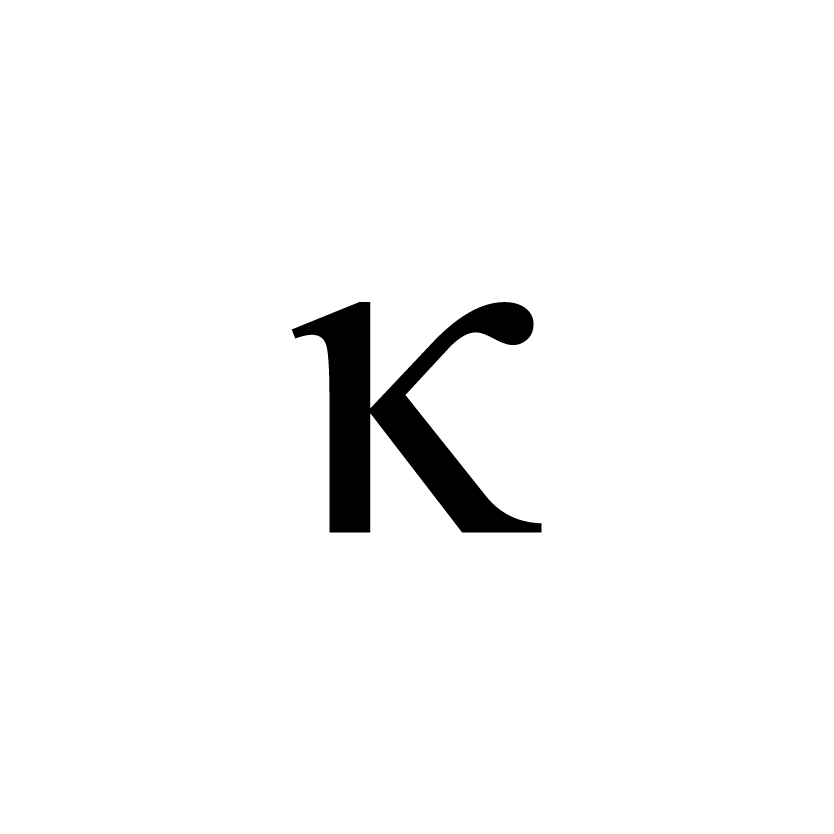Kappa Symbol (Κ κ)
Copy and use the Kappa symbol - both uppercase and lowercase versions
Κ
κ
What is the Kappa Symbol?
The Kappa symbol (Κ, κ) is the 10th letter of the Greek alphabet. It represents the 'k' sound in Modern Greek and has various important uses in mathematics, science, and other fields.
Uppercase Kappa (Κ)
Technical Details
- Unicode: U+039A
- HTML Code: Κ
- HTML Entity: Κ
- UTF-8 Encoding: 0xCE 0x9A
- LaTeX Command: \Kappa
- Unicode Category: Letter, Uppercase
Alternative Names
- Common Names: Capital Kappa, Upper Kappa
- Greek Name: Κάππα (Káppa)
- Ancient Greek: Κάππα (Káppa)
- Phoenician Origin: 𐤊 (Kaph)
- Biblical Greek: Κάππα (Kappa)
Lowercase Kappa (κ)
Technical Details
- Unicode: U+03BA
- HTML Code: κ
- HTML Entity: κ
- UTF-8 Encoding: 0xCE 0xBA
- LaTeX Command: \kappa
- Unicode Category: Letter, Lowercase
Alternative Names and Uses
- Common Names: Small Kappa, Lower Kappa
- Mathematical Usage: κ-coefficient, kappa factor
- Variations: ϰ (kappa symbol variant)
- Scientific Symbol: Thermal conductivity (κ)
- Statistical Usage: Cohen's kappa (κ)
Historical Background
The Kappa symbol originated from the Phoenician letter 'Kaph', which meant "palm of the hand." It was adopted by the Greeks around the 8th century BCE and has been continuously used since then. The symbol's form has remained relatively stable throughout its history, making it one of the more recognizable letters of the Greek alphabet.
The Phoenician letter Kaph (𐤊) evolved into the Greek Kappa (Κ), which later influenced the development of the Latin letter K. This evolutionary path demonstrates the interconnected nature of ancient writing systems and their modern descendants.
Linguistic Features
Pronunciation
- Modern Greek: [k] as in "key"
- Ancient Greek: [k] (unaspirated)
- IPA Symbol: /k/
- Position: Velar plosive consonant
Writing System
- Alphabetic Position: 10th letter
- Numerical Value: 20 (in Greek numerals)
- Direction: Left-to-right
- Script Type: Alphabetic
How to Type the Kappa Symbol
Windows
Using Alt Codes
- Alt + 922 (Uppercase Κ)
- Alt + 954 (Lowercase κ)
Character Map
- Open Character Map (charmap.exe)
- Select "Greek" in the font dropdown
- Locate and select Kappa
- Click "Select" then "Copy"
macOS
Keyboard Shortcuts
- Option + k (Lowercase κ)
- Option + Shift + k (Uppercase Κ)
Character Viewer
- Press Control + Command + Space
- Search for "kappa"
- Double-click to insert
Other Methods
Word Processors
- Insert > Symbol > Greek
- LaTeX: \kappa (lowercase)
- LaTeX: \Kappa (uppercase)
HTML/CSS
- κ (lowercase)
- Κ (uppercase)
- \03BA (CSS content)
Mobile Devices
iOS
- Hold down 'k' on the keyboard
- Slide to select κ
- Or use Greek keyboard layout
Android
- Enable Greek keyboard in settings
- Switch to Greek input
- Type 'k' for κ
Common Uses of the Kappa Symbol
Mathematics and Statistics
- Cohen's Kappa (κ): A statistical measure of inter-rater reliability used to assess agreement between categorical items. Values range from -1 to +1.
- Heat Capacity Ratio: In thermodynamics, κ represents the ratio of specific heats (Cp/Cv). Also known as the adiabatic index.
- Curvature: In differential geometry, κ denotes the curvature of a curve or surface. Essential in the study of geometric shapes and manifolds.
- Von Kármán Constant (κ): A dimensionless constant used in fluid dynamics, approximately equal to 0.41. Critical in turbulent flow calculations.
- Condition Number: In numerical analysis, κ often represents the condition number of a matrix.
- Statistical Distributions: Used in various probability distributions and statistical formulas.
Physics and Engineering
- Thermal Conductivity: κ represents thermal conductivity in heat transfer equations, measured in watts per meter-kelvin (W/(m·K)).
- Dielectric Constant: The symbol κ is used for the relative permittivity of materials in electromagnetics. Critical in capacitor design.
- Wave Number: In optics and quantum mechanics, κ often represents the wave number, defined as 2π/λ.
- Coupling Coefficient: Used in various engineering contexts to represent coupling between systems.
- Spring Constants: Sometimes used to denote spring constants in mechanical systems.
- Acoustic Properties: Used in sound absorption and acoustic impedance calculations.
Chemistry and Biology
- Receptor Types: κ-receptors in biochemistry and pharmacology, particularly important in opioid receptor systems.
- Rate Constants: Used to denote specific rate constants in chemical kinetics and reaction mechanisms.
- Binding Constants: Represents equilibrium constants in biochemical reactions and protein-ligand interactions.
- Protein Structures: Used in describing certain protein conformations and secondary structures.
- Light Chain Types: In immunology, κ light chains are one of two types of light chain proteins in antibodies.
- Enzyme Kinetics: Used in various enzyme kinetics equations and constants.
Other Fields
- Finance: Used in financial formulas, particularly in risk assessment and portfolio theory.
- Computer Science: Appears in algorithm notation, complexity analysis, and programming languages.
- Linguistics: Used in the International Phonetic Alphabet (IPA) and phonological studies.
- Social Sciences: Applied in reliability coefficients and statistical measures in research.
- Economics: Used in economic models and capital theory.
- Psychology: Appears in psychometric formulas and statistical analyses.
Historical and Cultural Significance
The Kappa symbol has been used in scientific notation since ancient times. Its versatility across different fields of study makes it one of the most frequently used Greek letters in scientific literature. The symbol's usage has evolved from its original linguistic role to become a standard notation in various scientific disciplines, particularly in physics and mathematics.
Modern Applications
In the digital age, the Kappa symbol has found new applications in computer programming, data science, and digital communications. Its clear visual distinction from other symbols makes it ideal for mathematical and scientific notation in digital formats. The symbol continues to be adopted in emerging fields such as quantum computing and artificial intelligence research.
Frequently Asked Questions
What is the Kappa symbol used for?
The Kappa symbol (Κ, κ) has multiple uses across different fields. In mathematics, it's used for the heat capacity ratio and Cohen's Kappa coefficient. In physics, it represents thermal conductivity. In statistics, it's used for measuring inter-rater reliability. The symbol also appears in chemistry, biology, and engineering applications.
How do I type the Kappa symbol on my keyboard?
On Windows, you can type the Kappa symbol using Alt + 922 (Κ) or Alt + 954 (κ). On macOS, use Option + k for lowercase (κ) and Option + Shift + k for uppercase (Κ). Alternatively, you can copy the symbol directly from our website or use your system's character map/viewer.
What's the difference between Κ and κ?
Κ is the uppercase (capital) Kappa symbol, while κ is the lowercase version. While they represent the same letter, they might be used differently in mathematical or scientific notation. Generally, uppercase Kappa is used at the beginning of sentences or for specific constants, while lowercase kappa is more common in mathematical formulas and scientific notation.
Is there a difference between the Greek Kappa and the Latin K?
Yes, while they look similar and represent similar sounds, the Greek Kappa (Κ) and Latin K are different characters. The Greek Kappa has its own Unicode code points (U+039A for uppercase, U+03BA for lowercase) and is used specifically in Greek text and scientific notation.
Why isn't the Kappa symbol copying on my device?
If you're having trouble copying the Kappa symbol, it might be due to browser permissions or clipboard access restrictions. Try using the dedicated copy buttons on our website, which include fallback methods for older browsers. Alternatively, you can use your system's character map or Unicode input methods.
Can I use the Kappa symbol in HTML?
Yes, you can use the Kappa symbol in HTML using either HTML entities (Κ for uppercase, κ for lowercase) or Unicode values (Κ for uppercase, κ for lowercase). Make sure your HTML document is properly encoded with UTF-8.
Greek Alphabet Reference
| Name | Uppercase | Lowercase |
|---|---|---|
| Alpha | ||
| Beta | ||
| Gamma | ||
| Delta | ||
| Epsilon | ||
| Zeta | ||
| Eta | ||
| Theta | ||
| Iota | ||
| Kappa | ||
| Lambda | ||
| Mu | ||
| Nu | ||
| Xi | ||
| Omicron | ||
| Pi | ||
| Rho | ||
| Sigma | ||
| Tau | ||
| Upsilon | ||
| Phi | ||
| Chi | ||
| Psi | ||
| Omega |
Download Kappa Symbol Images
About the Images
These high-quality Kappa symbol images are available in both SVG and PNG formats:
- SVG Format: Vector graphics that can be scaled to any size without losing quality. Perfect for web design, presentations, and print materials.
- PNG Format: High-resolution raster images with transparent backgrounds. Ideal for digital use and when vector formats aren't supported.

